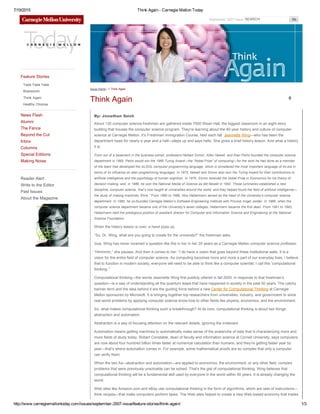
Think Again - Carnegie Mellon Today 2007
- 1. 7/19/2015 Think Again Carnegie Mellon Today http://www.carnegiemellontoday.com/issues/september2007issue/featurestories/thinkagain/ 1/3 September 2007 Issue SEARCH Go Feature Stories Yada Yada Yada Brainstorm Think Again Healthy Choices News Flash Alumni The Fence Beyond the Cut Inbox Columns Special Editions Making Noise Reader Alert Write to the Editor Past Issues About the Magazine Issue Home | > Think Again Think Again 0 By: Jonathan Szish About 130 computer science freshmen are gathered inside 7500 Wean Hall, the biggest classroom in an eightstory building that houses the computer science program. They’re learning about the 40year history and culture of computer science at Carnegie Mellon. It’s Freshman Immigration Course, held each fall. Jeannette Wing—who has been the department head for nearly a year and a half—steps up and says hello. She gives a brief history lesson. And what a history it is: From out of a basement in the business school, professors Herbert Simon, Allen Newell, and Alan Perlis founded the computer science department in 1965. Perlis would win the 1966 Turing Award—the “Nobel Prize” of computing—for the work he had done as a member of the team that developed the ALGOL computer programming language, which is considered the most important language of its era in terms of its influence on later programming languages. In 1975, Newell and Simon also won the Turing Award for their contributions to artificial intelligence and the psychology of human cognition. In 1978, Simon received the Nobel Prize in Economics for his theory of decision making, and, in 1986, he won the National Medal of Science as did Newell in 1992. These luminaries established a new discipline, computer science, that’s now taught at universities around the world, and they helped found the field of artificial intelligence— the study of making machines “think.” From 1980 to 1988, Nico Habermann served as the head of the University’s computer science department. In 1985, he cofounded Carnegie Mellon’s Software Engineering Institute with Provost Angel Jordan. In 1988, when the computer science department became one of the University’s seven colleges, Habermann became the first dean. From 1991 to 1993, Habermann held the prestigious position of assistant director for Computer and Information Science and Engineering at the National Science Foundation. When the history lesson is over, a hand pops up. “So, Dr. Wing, what are you going to create for the university?” the freshman asks. Gulp. Wing has never received a question like this in her in her 20 years as a Carnegie Mellon computer science professor. “Hmmmm,” she pauses. And then it comes to her: “I do have a vision that goes beyond these institutional walls. It is a vision for the entire field of computer science. As computing becomes more and more a part of our everyday lives, I believe that to function in modern society, everyone will need to be able to think like a computer scientist. I call this ‘computational thinking.’” Computational thinking—the words Jeannette Wing first publicly uttered in fall 2005, in response to that freshman’s question—is a way of understanding all the quantum leaps that have happened in society in the past 50 years. The catchy banner term and the idea behind it are the guiding force behind a new Center for Computational Thinking at Carnegie Mellon sponsored by Microsoft. It is bringing together top researchers from universities, industry, and government to solve realworld problems by applying computer science knowhow to other fields like physics, economics, and the environment. So, what makes computational thinking such a breakthrough? At its core, computational thinking is about two things: abstraction and automation. Abstraction is a way of focusing attention on the relevant details, ignoring the irrelevant. Automation means getting machines to automatically make sense of the avalanche of data that is characterizing more and more fields of study today. Robert Constable, dean of faculty and information science at Cornell University, says computers are now about four hundred billion times faster at numerical calculation than humans, and they’re getting faster year by year—that’s where automation comes in. For example, some mathematical proofs are so complex that only a computer can verify them. When the two As—abstraction and automation—are applied to economics, the environment, or any other field, complex problems that were previously unsolvable can be solved. That’s the gist of computational thinking. Wing believes that computational thinking will be a fundamental skill used by everyone in the world within 50 years. It is already changing the world. Web sites like Amazon.com and eBay use computational thinking in the form of algorithms, which are sets of instructions— think recipes—that make computers perform tasks. The Web sites helped to create a new Webbased economy that trades